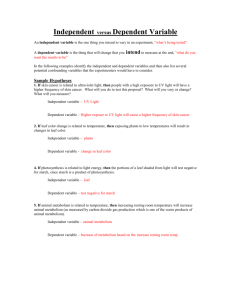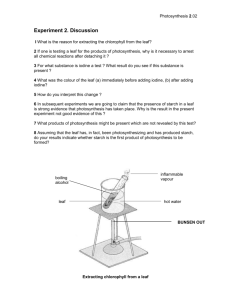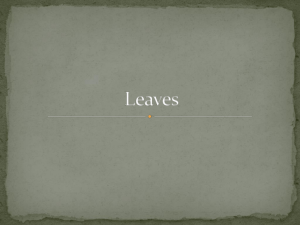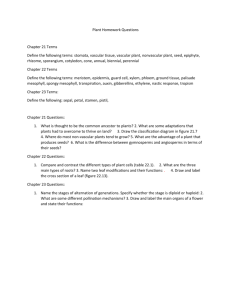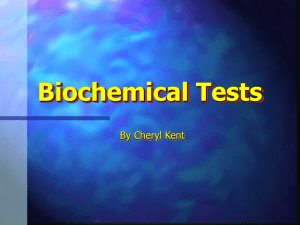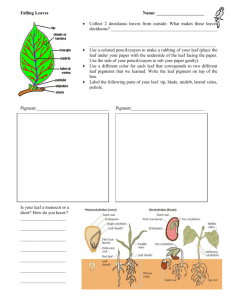AICE Biology Lab Review
advertisement
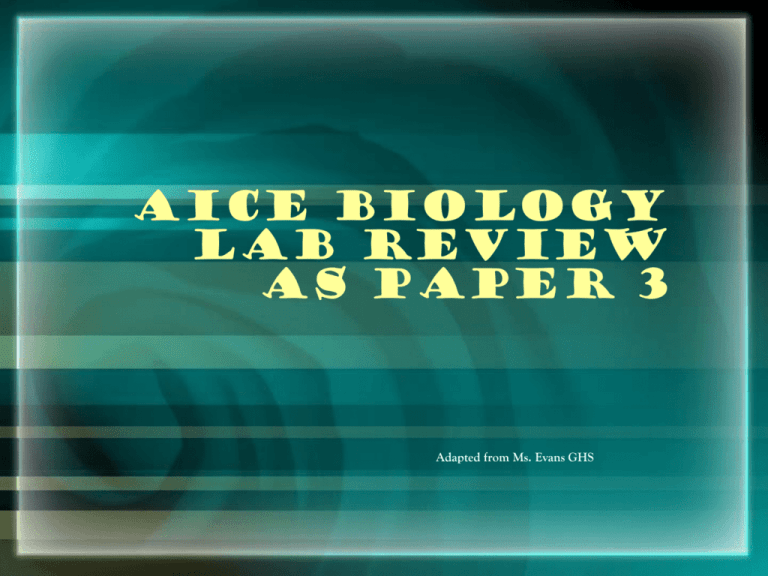
AICE Biology Lab Review AS Paper 3 Adapted from Ms. Evans GHS Metric Units (Length) • • • • • • kilometer (km) = 1,000 m (1 X 103 m) meter (m) = 1 m centimeter (cm) = 0.01 m (1 X 10-2 m) millimeter (mm) = 0.001 m (1 X 10-3 m) micrometer (um) = 0.000001 m (1 X 10-6 m) nanometer (nm) = 0.000000001 m (1 X 10-9 m) • **To convert between any, use the same method you used in stoichiometry & keep track of units A. Cell Structure (a) Use a graticule and stage micrometer to measure cells and be familiar with units (mm, µm, nm) Example: A lysosome measures 0.4 µm in diameter. What is the diameter in nm? A 4nm B 40 nm C 400 nm D 4000 nm Calibrating an Eyepiece Graticule Images from “Measuring” Leica microsystems www.leica-microsystems.com Measuring With A Graticule Images from “Measuring” Leica microsystems www.leica-microsystems.com Practice measuring Images from “Measuring” Leica microsystems www.leica-microsystems.com Measuring With A Graticule: PRACTICE The diagram shows a graduated slide, with divisions of 0.1 mm viewed using an eyepiece graticule. Pollen grains were grown in a sugar solution and viewed using the eyepiece graticule. Diagram 1 shows the pollen grains at first and diagram 2 shows them after four hours. Difference Between Magnification & Resolution • Magnification: zooms in, makes small objects larger to see detail • Resolution: The shortest distance that can be distinguished between two objects Calculating Magnification Magnification = Image / Actual • Example 1: The diagram is a plan of a transverse section through a leaf, drawn using a x 5 eyepiece and a x 8 objective lens of a microscope. The actual distance across the leaf section is 7.5mm. What is the magnification of the diagram? A x5 Bx8 C x 20 D x 40 Calculating Magnification Magnification = Image / Actual • Example 3: The diagram shows a drawing of an electronmicrograph. What is the approximate length of one mitochondrion in this cell? (Assume the line = 7mm) A B C D 5 to 6 µm 7 to 8 µm 8 to 10 µm 10 to 15 µm A. Cell Structure (e) Compare & contrast the structure of typical animal & plant cells A. Cell Structure (f) Draw plan diagrams of tissues (including transverse section of a dicotyledonous leaf) and calculate the linear magnification of drawings. B. Biological Molecules (a) Carry out tests for reducing and non reducing sugars (including semi quantitative use of the Benedict’s test), the iodine in potassium iodide test for starch, the emulsion test for lipids and the biuret test for polypeptides. Benedict’s Test for reducing sugars 1. Mix equal amounts of test solution and Benedict’s. 2. Heat until nearly boiling for color change. 3. Identify relative concentrations of reducing sugars based on degree of color change. Benedict’s Test for reducing sugars Here’s a good example of some possible test solutions Testing for non reducing sugars (sucrose) • If you get a negative result for your Benedict’s test, you can rule out the presence of reducing sugars like glucose, fructose & lactose, but further testing is needed to rule out sucrose. • There are two methods to use Benedict’s test to test for Non-reducing sugars: Acid Hydrolysis & Enzyme Hydrolysis. Testing for non reducing sugars (sucrose): Acid Hydrolysis • After a neg result, get a fresh solution and add dilute HCL. Heat for 10 minutes to break any glycocidic bonds present. • Then, add Hydrogen Carbonate to your sample until it ceases to fizz. This neutralizes the HCL in your sample. • Now, add Benedicts Solution to your sample and heat for 1015 minutes. • If you see a color change where you previously had a negative test, this is a positive test for non-reducing sugars (eg. sucrose) or starches in the solution. • Use the IKI test to narrow down your results • +positive IKI means you have either starch only or a mixture of starch & sucrose • -Neg. IKI means you have sucrose only. Testing for non reducing sugars (sucrose): Enzyme Hydrolysis • This is just like Acid Hydrolysis except you can use an enzyme like Amylase to break the glycosidic bonds. • When you use an enzyme you need to be more careful when you heat the solution to ensure that you do not denature the enzyme. • No hydrogen carbonate is needed when using the enzyme. • After adding the enzyme & heating gently for 10 minutes you add the Benedict’s solution and proceed as usual for any Benedict’s test. • Potassium Iodide (IKI) test for Iodine solution (IKI) reacts with starch to starch produce a dark purple or black color. Left: starch solution and IKI - Iodine turns dark in the presence of starch. Right: distilled water and IKI Emulsion Test for Lipids This one can be difficult to interpret. Look closely for small droplets of oil suspended in the emulsion. Biuret Test for peptide bonds (protein) + Positive test is lavender to purple, - Negative is sky blue • (b) describe the ring forms of alpha and beta glucose. • Alpha and beta glucose differ only in the direction that -H and -OH groups point on carbon 1. Alpha glucose has an -OH [hydroxyl] group that points "downwards", away from the ring, whereas the -OH on carbon 1 of beta glucose is above the ring. (c) Describe the formation and breakage of a glycosidic bond. • (d) describe the molecular structure of starch (amylose & amylopectin), glycogen & cellulose and relate these structures to their functions in living organisms. Starch (amylose & amylopectin) • Function: store energy for plants • Structure: many glucose molecules in a lattice configuration (crisscrossing) Glycogen • Function: Store glucose in animals • Structure: Highly branched glucose polymer Cellulose • Function: Structural support in plants • Structure: straight chain polymer, and each cellulose molecule is long and rod-like. This differs from starch, which is a coiled molecule. This is why cellulose cannot be broken down into its glucose subunits by any enzymes produced by animals. • (e) describe the molecular structure of a triglyceride & phospholipid and relate these structures to their functions in living organisms. Triglyceride • Structure: glycerol & 3 fatty acids • Function: Energy storage; saturated (bad) & unsaturated (better) fats Phospholipid • Structure: phosphate group as a “head” (hydrophilic) with 2 fatty acid tails (hydrophobic); both bonded to a molecule of glycerol • Function: Makes cell membranes with differing abilities to allow diffusion of materials across and allows solubilities in both oil & water • (f) describe the structure of an amino acid and the formation & breakage of a peptide bond. Amino Acids • 20 of them Peptide Bond • (g) explain the meaning of the terms primary, secondary, tertiary, and quaternary structure of proteins and describe the types of bonding (hydrogen, ionic, disulphide and hydrophobic interactions) that hold the molecule in shape. Primary Structure • Covalent bonding between adjacent amino acids (or peptide bonds) Secondary Structure • The helix is stabilized by hydrogen bonding between amine and carbonyl groups of the same polypeptide chain. The pleated sheet is stabilized by hydrogen bonds between the amine groups of one chain and the carbonyl groups of an adjacent chain. Tertiary Structure • Tertiary structure is largely maintained by disulfide bonds. Disulfide bonds are formed between the side chains of cysteine by oxidation of two thiol groups (SH) to form a disulfide bond (S-S), also sometimes called a disulfide bridge. Quaternary Structure • Hydrophobic interaction is the main stabilizing force for subunits in quaternary structure. When a single monomer folds into a three-dimensional shape to expose its polar side chains to an aqueous environment and to shield its nonpolar side chains, there are still some hydrophobic sections on the exposed surface. Two or more monomers will assemble so that their exposed hydrophobic sections are in contact. • Although rare, ionic bonds can be important to protein structure because they are potent electrostatic attractions that can approach the strength of covalent bonds • (h) describe the molecular structure of haemoglobin as an example of a globular protein, and of collagen as an example of a fibrous protein & relate these structures to their functions. Haemoglobin • Made of 4 polypeptide chains: 2 alpha & 2 beta globin chains • Each a or b globin chain folds into 8 a helical segments (A-H) which, in turn, fold to form globular tertiary structures that look roughly like submicroscopic kidney beans. The folded helices form a pocket that holds the working part of each chain, the heme which holds the iron. • Function: to carry oxygen to cells, which binds to the oxygen in the heme group. Collagen • Fibrous proteins generally exist as water-insoluble strands (as opposed to globular "ball-shaped" proteins which are soluble in water.) The chains have a high percentage of hydrophobic amino acids that allows them to coalesce into strong linear chains, ie. collagen exists as a "triple helix." These strands usually come together to form very strong, rope like structures that resist "where-and-tear" and have tensile strands. Hence they are found in joints, ligaments, tendon, muscle, connective tissue, the skin and other tissues that are exposed to heavy mechanical stress, examples of these proteins are the collagens found in connective tissue, cytokeratins in the epidermis, desmin in muscle tissue and elastins, which consists of a high proportion of alpha helixes that can "uncoil" and "stretch." • (j) state one role of each of the following inorganic ions in living organisms: calcium, sodium, potassium, magnesium, chloride, nitrate, phosphate C. Enzymes (c) Follow the time course of an enzymecatalysed reaction by measuring rates of formation of products (for example, using catalase) or rates of disappearance of substrate (for example using amylase). C. Enzymes (d) Investigate and explain the effects of temperature, pH, enzyme concentration, and substrate concentration on the rate of enzyme - catalysed reactions, and explain these effects. D. CELL MEMBRANES AND TRANSPORT (d) investigate the effects on plant cells of immersion in solutions of different water potential; E. CELL AND NUCLEAR DIVISION (Mitosis) (d) *describe, with the aid of diagrams, the behaviour of chromosomes during the mitotic cell cycle and the associated behaviour of the nuclear envelope, cell membrane, centrioles and spindle (names of the main stages are expected); G. TRANSPORT (Plants) (c) *describe how to investigate experimentally the factors that affect transpiration rate; (d) *describe the distribution of xylem and phloem tissue in roots, stems and leaves of dicotyledonous plants; (e) *describe the structure of xylem vessel elements, sieve tube elements and companion cells and be able to recognise these using the light microscope; (i) *describe how the leaves of xerophytic plants are adapted to reduce water loss by transpiration; Plants: Monocots versus Dicots • The flowering plants (angiosperms) are classified as either monocots or dicots based on characteristics of their pollen, leaves, roots, stems and flowers. • Monocots include lilies, corn, rice, palms and grasses. • Dicots include pretty much everything else- including all woody plants. The three tissue systems in the plant body Tracheid (xylem cell) Vessel element (xylem cell) Sieve tube element Phloem tissue Xylem Tissue Tracheid Vessel element Phloem Tissue Sieve tube element Companion cell Monocots Dicots Monocot Root Cross Section (cs) Dicot Root Cross Section (cs) Monocot Stem Dicot Stem Monocot Leaf • Midrib shows vascular tissue: Can you ID? • Leaves have parallel veins (visible here) • Do you see the stomata? Monocot Leaf: Zea Mays (corn) The mesophyll of Zea is undifferentiated. Note the large bundle sheath cells and that stoma are found in both the upper and lower epidermis. Dicot Leaf • These leaves have a more obvious mid-rib (central vein) • Veins are perpendicular to the central vein. 40x . This image shows the large central vein (vascular tissue) in the middle of a dicot leaf. The white areas inside the leaf are air spaces, which allow the cells to take up carbon dioxide gas for photosynthesis. The rows of elongated cells near the top surface of the leaf are the palisade layer, where most of the photosynthesis takes place. Mesophyte Dicot Leaf: Ligustrum Mesophytic leaves are adapted to average conditions. Note the well differentiated mesophyll with a palisade mesophyll on the upper surface and the spongy mesophyll below. Mesophyte Leaf: Prunus (Laurel) At 3 different magnifications Stomata Identify the guard cells that both form the stoma and regulate its size. Hydrophytes: Water Loving Plants Hydrophytic leaves are adapted to an aquatic existence. Note that the upper palisade mesophyll is well developed for photosynthesis while the lower portion of the mesophyll is very loosely arranged with considerable open space which helps the leaf float to the surface. The loosely arranged tissue of the lower mesophyll is aerenchyma. stoma are located in the upper epidermis. Xerophytes : Ammophilia (Marram Grass) More Xerophyte Dicot leaves: Pinus The pine leaf is well adapted to dry conditions with a thick epidermis with stoma recessed into the surface. Beneath the epidermis is the thick walled cells of the hypodermis which helps reduce water evaporation from the leaf. The pine leaf has an endodermis inside the mesophyll which is not seen in either of the other leaf types observed. More Xerophytes: Oleander 200X More Xerophytes: Oleander 400X G. Transport: Mammals (l) *describe the structures of arteries, veins and capillaries and be able to recognise these vessels using the light microscope; Artery & Vein Cross section Comparison H. GAS EXCHANGE • (a) *describe the structure of the human gas exchange system, including the microscopic structure of the walls of the trachea, bronchioles and alveoli with their associated blood vessels; • (b) *describe the distribution of cartilage, ciliated epithelium, goblet cells and smooth muscle in the trachea, bronchi and bronchioles; Trachea Lung Tissue J. IMMUNITY / Mammalian Transport (n) *describe the structure of red blood cells, phagocytes and lymphocytes and explain the differences between blood, tissue fluid and lymph; (Transport) (a) *recognise phagocytes and lymphocytes under the light microscope; Blood smear Medium Lymphocyte (yellow) Neutrophils (green) Bar = 50 Microns (µm)


